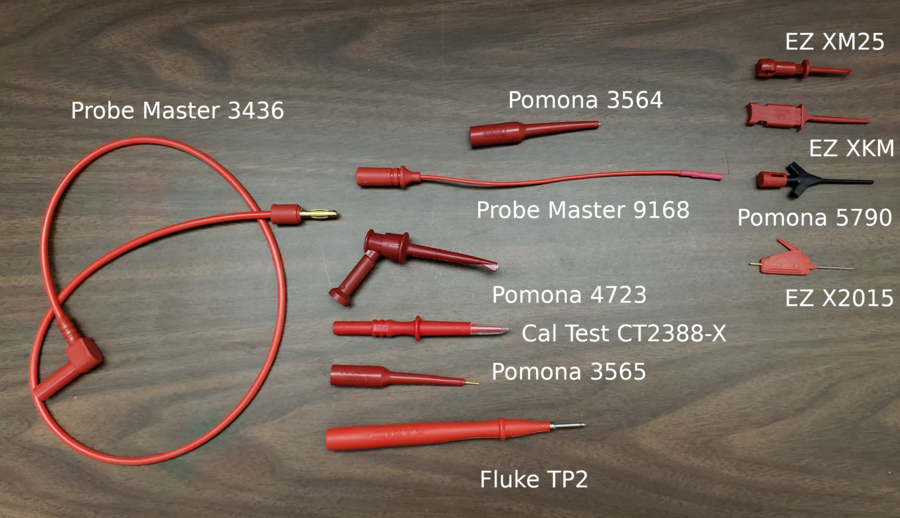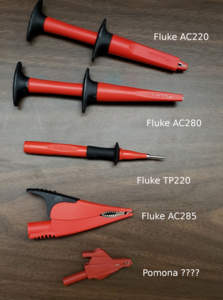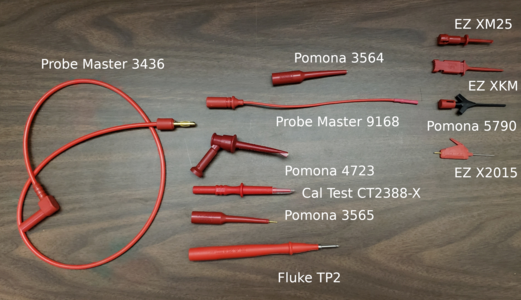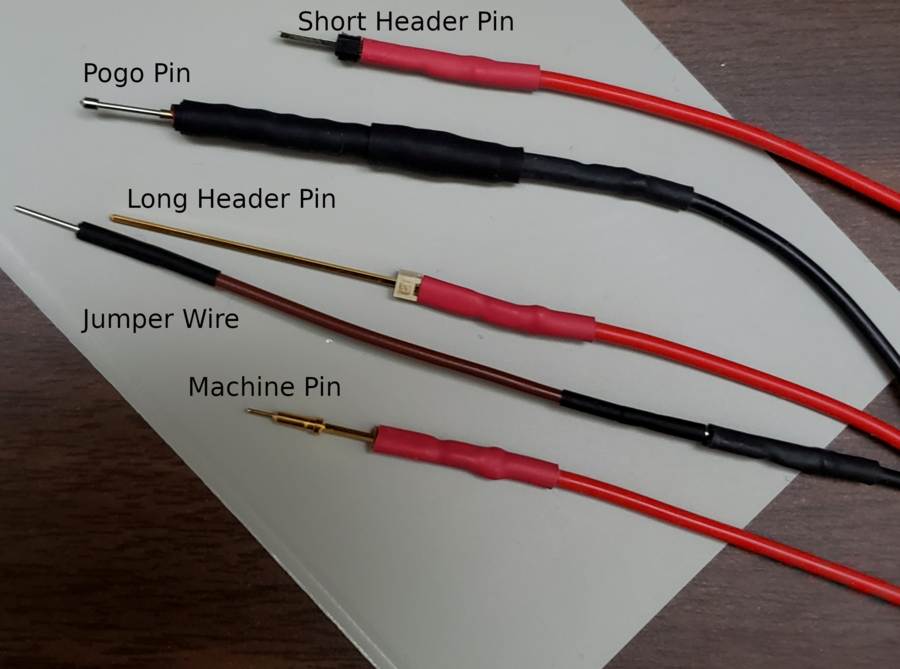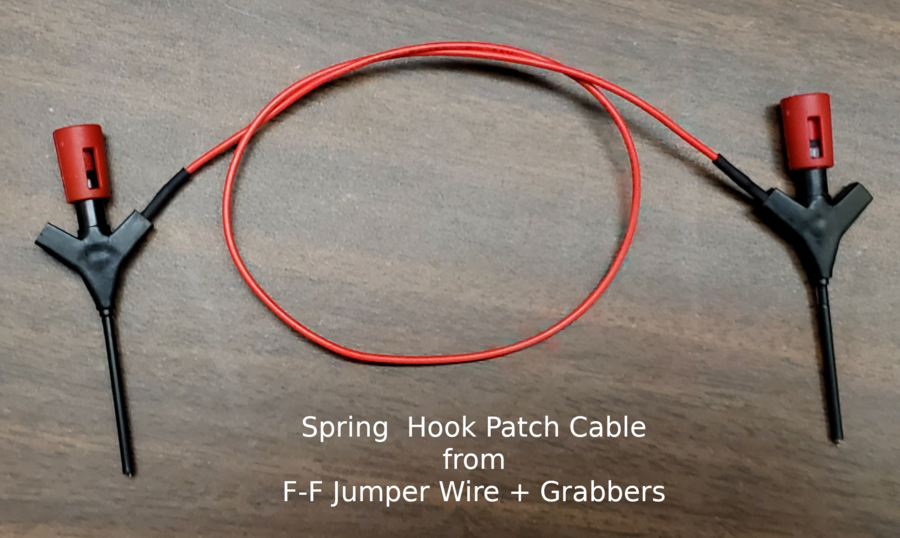Mitch Richling: DMM Probes
| Author: | Mitch Richling |
| Updated: | 2023-01-21 |
Table of Contents
1. Introduction
Back in the day when I became interested in electronics, through hole components were very common. People would actually snap an MCU into a solderless breadboard and wire it up! Today surface mount dominates, and prototyping is heavily dependent upon breakout and EVM boards. Everything has shrunk – except my DMM cables and probes!!
Compared to the tiny parts we work with today those 4mm banana jacks, 18 gauge leads, meter long cables, and probes the size of an old fountain pen all just seem enormous. In today's world of fine pitch ICs and pin headers, standard DMM probes are all wrong.
2. Requirements
2.1. Observations
I eventually got frustrated enough that I wanted to find a better solution, and so I started to pay more attention to what I was doing at the bench.
- What I'm probing
- 70% of the time I'm probing a pin header or socket!
- 20% of the time I'm probing an IC pin – the most common pitch I probe is 0.5mm
- The rest of the time includes all kinds of edge cases like automotive and work around the house
- At the bench
- 99% of my probing is at the bench
- 30% of the time I'm using a probe, and the rest I'm using a grabber
- 60% of my voltage measurements are single ended with the ground point being a pin header/socket or banana socket
- Rarely work on anything over 20V
- The test equipment is generally less than 12 inches away from the DUT
- Long leads frequently clutter my workspace
2.2. The form of the solution
I like the flexibility modular DMM probes provide, and they still work very well off the bench. Unfortunately they don't work well on the bench because the sheathed DUT ends are too bulky, the probes are too large, and the leads are far too long. Things I wanted in a solution:
- Continue using my modular probes and leads for non-bench work
- A similar, modular solution appropriate for smaller geometry work on the bench
- Hopefully these two modular solutions can work together to make both better
2.3. Probe form factors
- Various large grabbers, clamps, and probes for automotive and household work
- Unsheathed banana plug
- Medium sized grabbers for pin headers, wires, and through hole components
- Standard sized DMM probe
- Spring loaded, needle SMT probes
- Pin socket to attach to a pin header
- Pin to insert into a pin socket
- Small grabbers for headers
- Tiny grabbers for IC pins
3. My Solution
3.1. The leads
Items 1-7 all exist as standard modular probe with banana sockets. Items from 6-9 exist in modular form equipped with a 0.025" pin. Note the overlap for 6 & 7.
So if we could find some modular DMM probes with shorter cables and a compact, unsheathed DUT end we would be in business. After a bit of searching I discovered Probe Master's custom DMM leads. So I ordered 24" custom modular DMM leads made with a 90 degree sheathed plug on the DMM end and a simple, unsheathed banana plug on the DUT end. They do good work, and I'm very happy with the results.
What about the modular probes with pins? I could get some banana plug to pin socket cables like the Pomona 4771-24, but that means I have two sets of leads! What I really wanted was an adapter to put on the end of my modular leads. Of the many options I evaluated, three stood out:
- Caltest Electronics CT3099-ND
- Probe Master 9168-025
- Pomona 3564
The adapter from Probe Master was the best. It fits onto a the banana DUT end of my modular leads without adding bulk, the six inch small gauge wire leading to the pin socket provides the flexibility required for smaller probes, and the socket itself is much better than average. I also kept the Pomona 3564 & 3565 adapters because they are quite nice for directly connecting to breakout board header pins & sockets.
3.2. Commercial Probes
- Smallest Grabber (E-Z-Hook X2015)
- Super thin so they stack side by side to probe adjacent pins. Great grabber. The tiny size makes them a bit delicate.
- Smaller Grabber (E-Z-Hook XKM)
- Good grabber. They stack well on 0.1" pitch parts, but it gets tight as things get smaller. I have a ton of these (both genuine EZ-Hook and knockoffs) as they are standard equipment shipped with a number of products.
- Smaller Grabber (Pomona 5790-X)
- Hold a bit better than the EZ-Hook XKM, and have a slightly thinner barrel; however, they don't stack well. These have essentially the same form factor as the Tek grabbers that came with Tek logic analyzers back in the day.
- Small Hook (E-Z-Hook XM25)
- Great for hanging onto a small wire or a header from the side. Less fiddly than double grabbers.
- Medium Hook (Pomona 4723-X)
- Great for larger wire, through hole components. They can work with 0.1" pitch headers too, but that's as tight as you want to get with these.
- Pin socket (Pomona 3564 )
- This is a flexible banana socket to pin socket adapter. I keep it in the bin, but I don't actually use this one much.
- Pin not-a-probe (Pomona 3565)
- Really just a flexible banana to pin adapter – not really a probe at all. It's perfect for probing a pin socket or solderless breadboard, but it also makes a pretty good general use probe. I find that I have this thing on the end of my cables far more than any of the probes listed below.
- SMD Probe (Caltest Electronics CT2388-X)
- Probably my second most used probe. This one has a very sharp, spring loaded tip. The whole thing is quite compact and slim.
- Most used full sized probe at the bench (Fluke TP2)
- For the uncommon occasions when I use a standard probe at the bench, this is the one. It's a little narrower than the TP220, and thus more appropriate for the bench.
- Favorite full sized probe (Fluke TP220)
- This one is grippy and has a good finger shield. My main, off-bench probe. It's a little to big to get much bench use.
- Long Hook (Fluke AC280)
- Great for reaching a wire through a hole in drywall or behind an electrical box
- Long Alligator Clips (Fluke AC220)
- Nice when you need to get to a wire or lug buried behind obstructions.
- Large Alligator Clips (Fluke AC285)
- Useful for attaching to large lugs or bolts under the hood
4. Not DMM Probes
4.1. Oscilloscope Probes
Oscilloscope probes share all the problems of DMM probes, and add more:
- Cable flexibility can be a real issue for scope probes making them hard to accurately position and keep in place
- It is virtually impossible to purchase scope probes with custom cable lengths
- As frequencies increase, things become very complex
- Scope probes are not fully interchangeable because of input capacitance, and so solutions may need to be scope specific
- Cable strain relief & compensation boxes are bulky frequently chewing up half a foot of air space in front of your scope
4.1.1. What I'm using
- Tektronix TDS3052B DPO
- Tektronix P6139A
- These are quite a bit smaller than standard probes, and the unique tip design makes them incompatible with many generic oscilloscope probe accessories. The good news is that parts and accessories for the CT3290RA from Caltest Electronics are widely available and work fine on the P6139A. Another bit of good news is that the screw-on, plastic probe tip cover they come with makes them compatible with many Tektronix probe spring hooks.
- Siglent SDS2000X+ MSO
- The actual input capacitance of my unit is around 22pF – quite a bit higher than the specification. Accordingly I have had trouble finding probes that
will compensate on this scope.
- Probemaster 4906-1RA
- These probes have a traditional 5mm diameter grounding ring, and are thus compatible with many probe accessories. Despite the standard 5mm size, they are a far more compact than many probes. The cables are flexible and of a manageable 1m in length. Probemaster provides a wide selection of reasonably priced, high quality accessories.
- Keysight N2873A
- When I really need 500MHz, these are the probes I use. They have 2.5mm barrels and very sharp, spring loaded pogo pin tips. The thicker, less flexible cables make them more awkward at the bench than the 4900's. While the barrels are 2.5mm, the rear grounding ring is 5mm so common probe grounding accessories will work – I use the Probemaster socket adapter. The rest of the probe design renders them incompatible with standard probe accessories. To make matters worse, few vendors provide compatible accessories, and Keysight accessories are absurdly expensive.
- Tektronix 2235 Analog CRT Scope
- Tektronix P6122
- Yep. These are the original probes that shipped with this scope in 1986! It's just sorta fun to use the original equipment with this
old scope.
;)
4.1.2. Some tricks
- Tip adapters
- If you have a standard 5mm probe, try a Probemaster adapter
- Mill-Max makes a wide range of sockets. Find one that fits your probe tip, and make yourself a tip to 0.25" socket adapter.
- Probing sockets & solderless breadboards
- I can sometimes get away with just inserting the probe tip directly in the socket.
- A header pin or M-M jumper to join socket and probe socket adapter
- Fine pitch chip pins
- I have had very good luck with probe comb tips like the Caltest Electronics CT3675, CT3676, & CT3677.
- A bit of folded cellophane can make a good, DIY shield between pins
- Higher frequencies in tight spots
- I use an old school wire wrap tool to spin a bit of 30 AWG solid wire around a probe tip and then solder the other end to the DUT. Don't try this on spring loaded probes.
- Use those those short spring ground leads or wrap your own around the ground ring
- Stick a square of conductive tape on the back of the chip and ground it. This makes a nice target for a spring ground lead.
- Probe positioning equipment (see: the probe positioning section of my workbench page)
- Photographic arms are far less expensive than probe positioners, and are manufactured by the same people.
- The PCBite from Sensepeek is a pretty good solution.
4.2. Jumper wires are more than just jumper wires
4.3. My Favorite Jumper Wires
- female to female (Schmartboard)
- These use high quality 28 AWG high temp wires with thin insulation. Thee sockets are quality, heat shrink covered spring sockets – not the bulky plastic sockets used by most manufacturers, but compact square sockets. Perfect for header to header connections.
- female to female (E-Z-Hook 9110)
- These are 22 AWG with flexible PVC insulation. The sockets are quality, heat shrink covered spring sockets. Because these are pretty flexible they are much easier to position with things like grabbers attached.
- male to male (Twin Industries)
- These use quality 24 AWG stranded wire with thin insulation. At the ends are heat shrink covered, high quality machine pins – not those folded sheet metal pins found in most jumper wires. As a bonus they also don't have those bulky plastic blocks. I use these quite frequently as probes and solderless breadboard jumpers.
- male to female
- I have yet to find a vendor that produces a cable with quality machine pins on one end and quality sockets on the other. If you know of one, let me know!
If you like super bendy jumpers and don't mind the square, plastic DIY ends, then the "Premium Silicone" ones from adafruit are a good option. I have found them to be more durable than similar jumpers.
